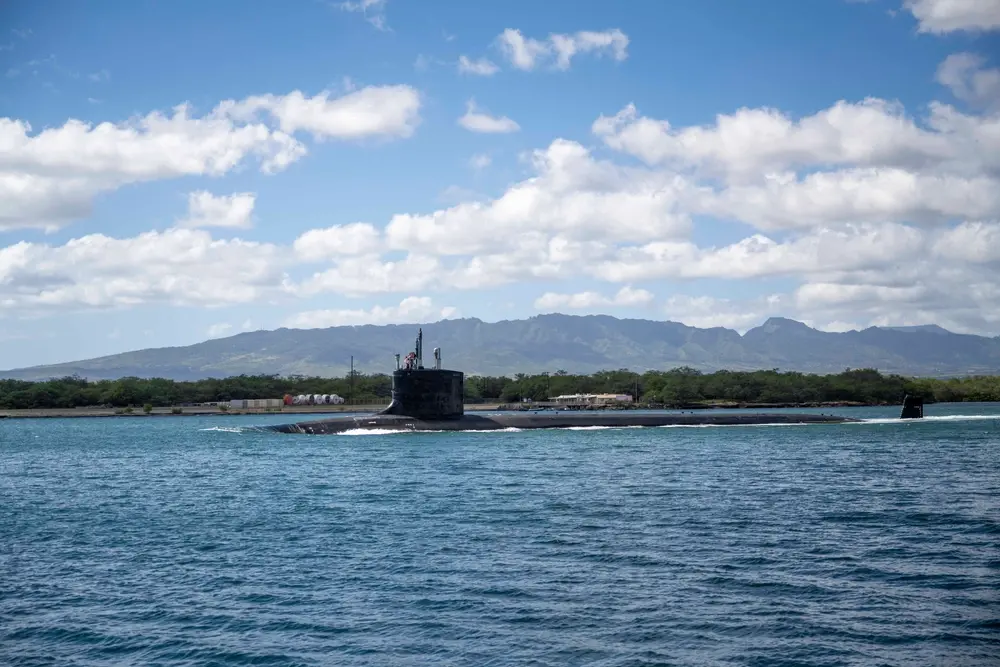According to industry sources, the U.S. Navy has added up to $1.85 billion to its multiyear Virginia-class attack-submarine contract with General Dynamics Electric Boat. The money covers early construction work and the purchase of long-lead components for the forthcoming Block VI boats. Defense officials confirm that $1.68 billion is obligated immediately from fiscal-year 2025 shipbuilding funds, while the balance becomes available once specific technical milestones close.
Electric Boat’s design hub in Groton, Connecticut will steer the effort, working in tandem with Huntington Ingalls’ Newport News yard in Virginia under their long-standing teaming arrangement. Our analysis shows the Navy wants critical hardware in the pipeline before detailed design freezes, limiting schedule risk once hull fabrication kicks off.
The award finances three broad task groups:
- Material buys for reactor vessels, high-strength hull cylinders, advanced sonar suites, and Virginia Payload Module frame sections.
- Tooling and process updates that fold Block VI design changes – such as improved acoustic coatings and unmanned-system interfaces – into yard workflows.
- Supplier-readiness actions that qualify new vendors, boost machining capacity, and secure hard-to-source alloys plus rare-earth magnets for the quiet-drive assembly.
Payments flow only after each deliverable passes Navy inspection, and all work must finish before September 2035. While the timeline appears generous, program managers note that some forged and heat-treated parts require multi-year lead times, leaving little margin for delay. This aligns with broader strategies such as the Pentagon Awards $5B Shipbuilding Contract to modernize supply chains across the U.S. Navy.
Industry briefings identify five material classes that the Navy insists on ordering early:
- Reactor forgings that demand 18-month heat cycles.
- Nickel-copper pressure-hull domes needing specialized presses.
- Hybrid composite-metal propulsors with tight tolerances.
- Photonics-mast sensor packages sourced from a limited vendor pool.
- Structural frames for the Virginia Payload Module, which stretch the hull an extra 84 feet.
Electric Boat expects these items to start shipping to Groton and Newport News by late 2026, lining up with planned keel-laying on the lead Block VI boat in 2027. The purchase of materials and specialized components ensures smooth workflow during production. GD Wins $882M Contract for New Vertical Sonar Arrays underscores their continued advancement in sonar technology.
Work spreads across at least fifteen states. Connecticut handles design engineering, module integration, and final testing. Virginia assembles bow and stern units. Pennsylvania forges thick-section steel. Arizona and Texas produce electronic modules, while Minnesota and Illinois mold composite structures. State development boards already report tool-and-die orders and new hiring drives, with Electric Boat alone planning about 3,000 additional craft staff over the next two years.
Block VI marks the sixth incremental upgrade to the Virginia program. Unlike previous blocks that focused on payload volume, Block VI concentrates on stealth and network integration. Defense officials confirm three standout features. First, an acoustic-superiority package reshapes the propulsor and adds a new anechoic tile pattern that cuts broadband noise. Second, hull connectors sized for tethered drones and seabed sensors give commanders more options for undersea surveillance. Third, a computing refresh swaps copper trunks for fiber and opens rack space for future electronic-warfare or autonomous-control modules. None of these changes alter the submarine’s reactor core or primary weapons capacity, so training and logistics stay familiar to fleet crews.
The Navy issued a separate $987 million change order on June 18 to handle component development and industrial-base expansion. That earlier tranche pays for design-center labor and supplier tooling. The new $1.85 billion line secures physical hardware. GD Electric Boat Navy Contract strengthens the support system for future fleet needs. Program leaders stress that both actions fit inside the original procurement plan approved by Congress in 2023, so no reprogramming request is required.
Our analysis points to broader industrial-base benefits. By locking in orders now, the Navy lets suppliers run hot rather than cycling from feast to famine. Stable volume supports investment in automation, additive manufacturing, and metrology gear that lift quality while cutting scrap. Small foundries and machine shops that specialize in submarine-grade alloys say advance orders make it easier to attract skilled workers who might otherwise leave manufacturing. The Revolver MP Torpedo System offers an example of how innovative manufacturing solutions improve production efficiency.
Funding for the Virginia program remains strong. Congress kept the two-sub-per-year authorization in the fiscal-year 2025 budget and set aside almost $11 billion for procurement and advance buys. If schedules hold, the first Block VI hull should roll out of Groton’s new Module Outfitting Facility in late 2031, roughly a year ahead of the follow-on SSN(X) demonstrator.
Strategically, the move addresses growing undersea competition. China has launched two more Type 095 nuclear attack boats in the past twelve months, and open-source acoustic data suggests steady noise-reduction gains. Defense officials say Block VI’s stealth margin helps preserve detection advantage until SSN(X) arrives in the mid-2030s. The award also bolsters the AUKUS timeline, since Australian acquisition plans rely on Virginia-class throughput to backfill U.S. fleet numbers once export deliveries start.
The regional workforce impact is immediate. Groton union representatives welcome predictable overtime that keeps journeyman welders from shifting into commercial construction. In Virginia’s Tidewater region, local press reports a surge in apprenticeship applications since the contract announcement. Midwest composite shops note fresh robotics installations funded by cost-sharing grants tied to the submarine supplier initiative.
Electric Boat engineers face a tight clock. They must lock the production baseline within twelve months, or long-lead orders risk mismatching final drawings. Yard supervisors anticipate first steel cut on structural ring segments by summer 2026, with early outfitting of piping and cabling modules soon after. Supply-chain managers still watch certain raw-material markets closely, especially high-purity hafnium needed for control-rod tips and specialty bearings.
Upstream, U.S. forging houses continue ramp-ups financed by the earlier $3.5 billion submarine-industrial-base fund. One Mid-Atlantic plant is installing a 90,000-ton press that can shape single-piece reactor heads, a move expected to shave six months off component schedules once qualified. Program officials say the latest contract modification dovetails with those upgrades, creating a clearer demand signal for heavy-capital investors.
Not everything runs on rails. According to industry sources, several electronic-module vendors still struggle with workforce retention, forcing them to rely on premium overtime. Electric Boat’s supplier-development team has embedded process engineers at the two most stressed firms, aiming to stabilize yield before volume ramps in 2027. Meanwhile, General Dynamics Wins $1.9B Contract highlights continued growth in support of Virginia-class submarine production, providing a stable demand signal for skilled labor. Lessons learned are feeding into the Navy’s broader Defense Industrial Base Resilience program.
Taking a wider view, the U.S. submarine construction line now fields Block IV boats in test, Block V hulls in early assembly, Columbia-class ballistic missile submarines at full tilt, and soon Block VI units on top. Our analysis shows that juggling four overlapping efforts pushes both yards to capacity. The long-lead purchase therefore acts as a pressure-release valve; by smoothing part deliveries, it keeps production bays moving without idle gaps or frantic catch-up shifts.
Financially, General Dynamics gains order backlog that extends through the next decade, easing revenue forecasting for Wall Street. Yet profit margins remain capped by the fixed-price incentive makeup of the parent contract. Executives have stated on earnings calls that efficiency gains, not change orders, drive returns. Still, steady Navy demand shields the shipbuilder from commercial volatility.
From the fleet’s perspective, the Virginia-class remains the workhorse of U.S. undersea warfare. Block VI’s enhancements stretch that role into a new era of autonomous systems and data-centric operations. By funding key pieces now, the Navy keeps its production rhythm intact and signals long-range confidence to allies and adversaries alike.
In closing, the $1.85 billion modification represents a calculated bet on timing. Ordering complex parts years in advance reduces risk downstream, supports domestic manufacturing, and keeps a critical deterrent program on track. The decision aligns resources with strategy without adding fresh layers of bureaucracy. Execution now moves from contract desks to factory floors, where thousands of skilled hands will shape steel, wind cables, and test electronics that together form the quiet heart of the next Virginia-class boats.
REFERENCE SOURCES
- https://news.usni.org/2025/03/25/report-to-congress-on-navy-next-generation-attack-submarine-2
- https://www.govconwire.com/article/gd-electric-boat-navy-virginia-class-submarine-support-contract
- https://www.ir-ia.com/news/us-navy-awards-1-85-billion-contract-for-next-generation-virginia-class-attack-submarines/
- https://www.nasdaq.com/articles/general-dynamics-wins-19b-contract-aid-virginia-class-submarines
- https://virginiabusiness.com/general-dynamics-subsidiary-wins-1-85b-contract-modification/
- https://defence-blog.com/u.s.-navy-awards-1-85b-for-next-gen-attack-subs/
- https://news.clearancejobs.com/2025/06/26/1-85-billion-navy-contract-boosts-virginia-class-submarine-program/
- https://news.usni.org/2020/11/20/navy-new-virginia-block-vi-virginia-attack-boat-will-inform-ssnx



